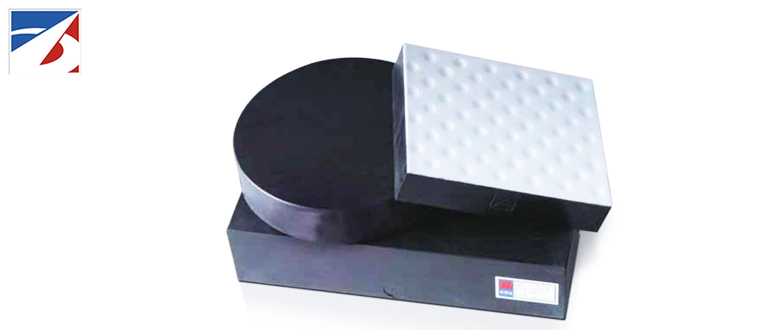Pot Bearing

Elastomeric Bearings
2018年3月26日
Spherical bearing
2019年1月10日Pot Bearing
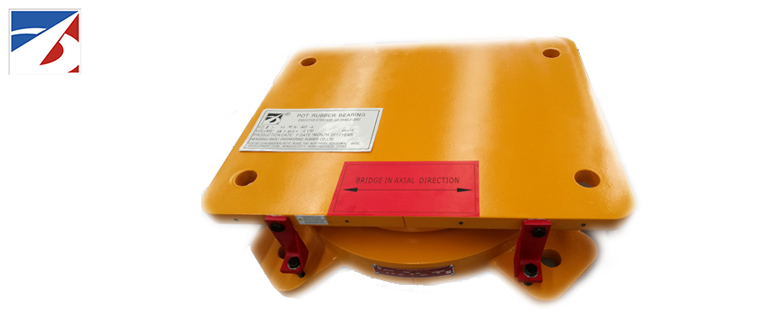
pot bearing
POT BEARING
All structures are flexible and their structural integrity must be maintained under all conditions. A structural bearing is essential to providing free movement between the superstructure and the supporting structure, while ensuring the safe transfer of vertical loads and rotations.
BAOLI pot bearings consist of an assembly of precision machined steel components and an elastometric disc confined at the centre. Designed and sized according to your project specific requirements, these bearings transfer large vertical loads while accommodating the structure’s relative displacement. Whether they are fixed, unidirectional or multidirectional, pot bearings transfer vertical and horizontal load combinations as well as longitudinal and transverse displacements. They can also be equipped with an uplift restraint device.
DESIGN PRINCIPLES
The design principle of BAOLI fixed type pot bearing is that restrains horizontal displacement, but allows rotational movement of the bridge structure about any horizontal axis by shear deformation of an elastomeric disc confined in a steel casing (pot plate).
The pot is machined from a standard steel plate to the proper dimensions. Brass sealing rings prevent the elastomeric disc encased in the pot from extruding under pressure through the annular gap located between the piston and the inside of the pot plate. The piston, which fits in the pot, is in contact with the elastomeric disc (Figure 1).
When sliding components are added, the fixed bearing becomes a mobile bearing that can accommodate horizontal displacement. This horizontal displacement can be multidirectional or unidirectional if a guiding system is provided. These sliding components consist of a polished stainless steel sheet welded to the underside of a steel plate and a PTFE disc bonded to the upper surface of the pot or piston plate. In order to increase its load-bearing capacity, the PTFE disc is recessed into the steel to a depth equal to approximately one-half of its thickness. The PTFE disc has small cavities (lubrication dimples) that contain a special lubricant to ensure permanent lubrication of the sliding surfaces.
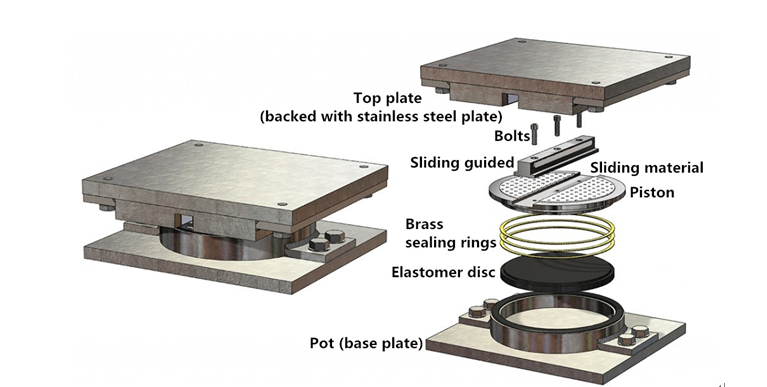
FEATURES
- Very low sliding friction
- Low eccentricity under vertical load and rotation
- Unlimited displacement capability
- Unlimited rotation capacity around vertical axis
- Horizontal rotation not reduced by guide system
- Replaceable
- Self-alignment capability
- Easy installation
- Low maintenance
Applications
BAOLI pot bearings can be used for bridges, railway and highway overpasses and buildings.
Applicable standards
- European Standard: EN 1337-5;
- American Standard: AASHTO LRFD Bridge Design Specification and Construction specification
- British Standard: BS 5400-9.1, BS 5400-9.2;
Baoli was awarded CE certification for Pot Bearings as per EN standard by KIT MPA Germany, we can also design and fabricate as per other standards and specifications.
Types
Fixed: Fixed bearings are immovable, can provide horizontal forces in all directions.
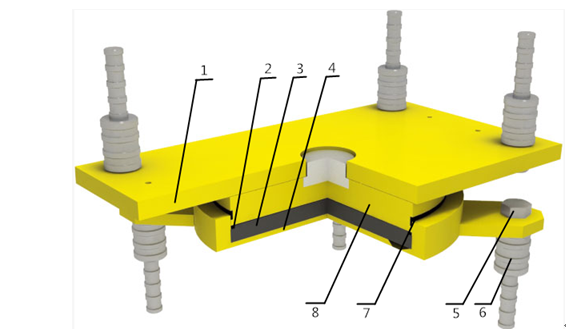
- 1. top plate; 2-brass seal; 3-elastomer disc; 4-pot; 5-anchor bolt; 6-sleeve; 7-rubber seal; 8-piston
Guided-sliding: Guided bearing can move in one direction, and may provide a horizontal force which perpendicular to that moveable direction.
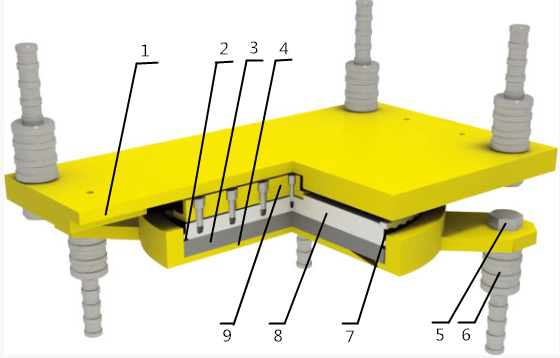
1-top plate; 2-brass seal; 3-elastomer disc; 4-pot; 5-anchor bolt; 6-sleeve; 7-rubber seal; 8-piston; 9-sliding guided part
Free-sliding: Free sliding bearings can move in all directions but cannot provide horizontal forces.
Material
- Steel elements
The Material And Standard Of Steel Elements
| Steel parts | Material | Standard |
| Pot | Cast steel or S355(Gr. 50) steel | EN, AASHTO |
| Piston | S355(Gr. 50) steel | EN, AASHTO |
| Top plate | S255( Gr. 36) | EN, AASHTO |
| Bolts | 41Ce4 ( Grade 100) | EN, AASHTO |
| Stainless steel | S304 | EN, AASHTO |
2. Elastomeric materials
The elastomeric material used for the elastomeric pad shall be natural or polychloroprene rubber in accordance with ISO6446.
Physical and mechanical propertied of elastomer disc
| Characteristics | Requirements | Test Methods | |||
| G Modulus (MPa) | 0.7 | 0.9a | 1.15 | ISO | Equivalent national standard |
| Tensile Strength (MPa)
Molded Test Piece Test Piece from Bearing Minimum elongation at break(%) Molded Test Piece Test Piece from Bearing |
≥16 ≥14
450 400 |
≥16 ≥14
425 375 |
≥16 ≥14
300 250 |
ISO 37
type2 |
GB/T
528-1998(Type 2) |
| Minimum Tear Resistance(KN/m)
CR NR |
≥7 ≥5 |
≥10 ≥8 |
≥12 ≥10 |
ISO 34-1
Trouser (Method A) |
GB/T 529-1999
(Pants type) |
| Compression Set(%)
24h; 72℃ |
CR ≤15 NR≤30 |
ISO 815
φ29×12.5mm, Spacer: 9.38mm,-25% |
GB/T
7759-1996 |
||
| Accelerated Ageing
(Maximum change from unaged value) -Hardness(IRHD) NR 7 d , 70℃ CR 3 d, 100℃ -Tensile strength(%) NR 7 d , 70℃ CR 3 d, 100℃ -Elongation at break(%) NR 7d , 70℃ CR 3d, 100℃ |
-5+10 ±5
±15 ±15
±25 ±25 |
ISO 48
ISO 188 |
GB/T
6031-1998 GB/T 3512-2001 |
||
| Ozone Resistance
Elongation: 30% – 96h 40℃±2℃ NR 25pphm CR 100pphm |
No cracks | ISO 1431-1 | GB/T 7762-2003 | ||
3. Brass sealing rings
The internal brass seal fitted into a formed recess in the upper edge of the elastomeric pad and consisted of a number of split rings to the internal diameter of the pot. Rings with a minimum cross-section of 10mm ×2mm may have slits 7mm deeps ×0.5mm wide spaced at 5 mm around the inner diameter to facilitate forming. Rings with a smaller cross-section have not slits.
Solid brass sealing ring configurations
| Diameter d (mm) | Minimum cross-section | slits | Number of rings |
| d≤330 | 6 ×1.5 | Not permitted | 2 |
| >330<715 | 10×1.5 | Not permitted | 2 |
| =715<1500 | 10×1.5 | Not permitted | 3 |
| <1500 | 10×2 | 7mm ×0.5mm
5mm spacing |
3 |
The material used for the brass seal is grade CuZn37 or CuZn39Pb3, as specified in EN 12163 and EN 12164 respectively, in the metallurgical condition used in the type tests.
- Stainless Steel
The stainless steel conform to ASTM A240/A240M, EN1337-5, or approved equivalent. The roughness of the surface in contact with the PTFE, measured in accordance with CSA B95, does not exceed an arithmetic mean of 0.25 μm.
- Sliding elements
PTFE sheets
The raw material of PTFE sheets are pure polytetrafluoroethylene free sintered without regenerated or filler materials.
Mechanical and physical properties of PTFE
| Property | Test standard | requirement |
| Mass density | EN ISO 1183(all parts) | ρp = 2140 to 2200 kg/m3 |
| Tensile strength | EN ISO527-1 and -3 | Fptk=29 to 40 MPa |
| Elongation at break | EN ISO527-1 and -3 | δp≥300 % |
| Ball hardness | EN ISO2039-1 | H132/60=23 to 33 MPa |
Modifies ultra-high molecular weight polyethylene (UHMWPE)
Modifies ultra-high molecular weight polyethylene (UHMWPE) have increased wear-resistance and load capacity, it is also suitable for use in sliding bearings for bridge and buildings. With grease dimples and high performance grease, a durable, low-friction sliding surface is ensured. In addition to its excellent physical properties, such as high resistance to wear and a high characteristic load capacity, UHMWPE can also be used at very low temperatures (as low as -58 oF/-50 ℃) and at high temperature (up to approximately 122 oF/-50 ℃). Due to its high durability, the use of UHMWPE greatly reduced maintenance and replacement costs.
Lubricant ( Silicon grease)
Physical and chemical properties of lubricant
| Properties | Requirements |
| Worked penetration | 26.5 to 29.5mm |
| Dropping point | ≥180 ℃ |
| Oil separation after 24 h at 100℃ | ≤3 %(mass) |
| Oxidation resistance pressure drop after 100h at 160℃ | ≤0.1 MPa |
| Pour –point of base oil | Below-60 ℃ |
Quality control at BAOLI
Baoli pot bearings are CE certified according to EN1337-5. All the required tests have been fulfilled in the ITT(Initial Type Test) and the FPC (Factory Production Control) is regularly monitored according to the regulations by MPA Stuttgart, Germany, a privileged independent supervisory body in the sector.
BAOLI have a strictly quality control system which complies with the regulations stipulated in EN1337-5.
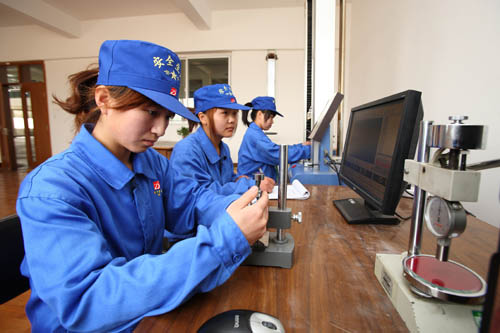
Hardness testing of rubber sheet
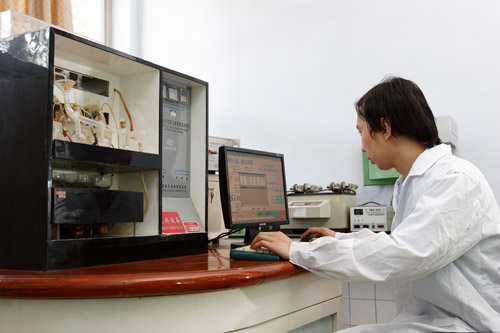
Inspect chemical component of steel plate
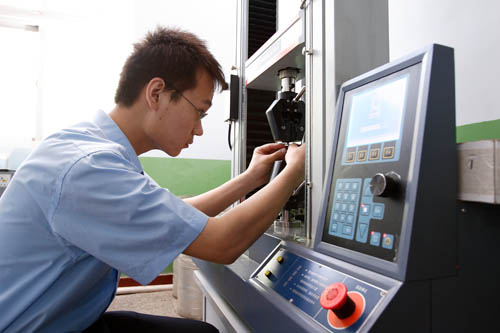
Elongation at break testing of rubber specimen
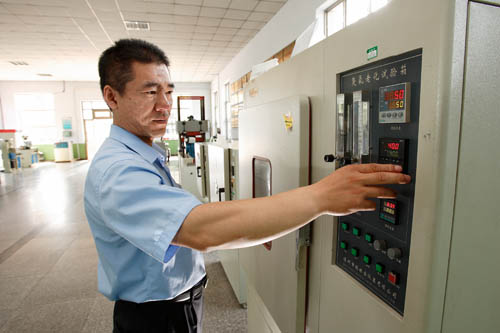
Ozone aging testing
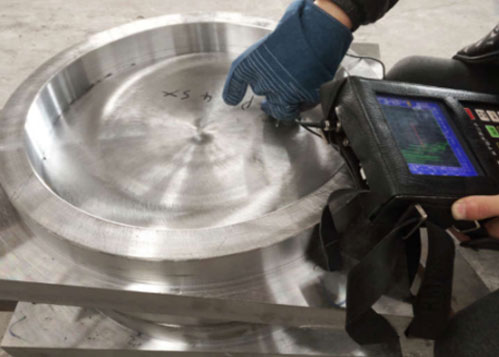
UT NDT testing on the pot part
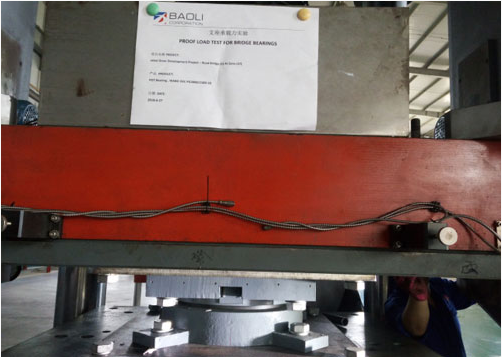
Vertical load and horizontal load testing
Production
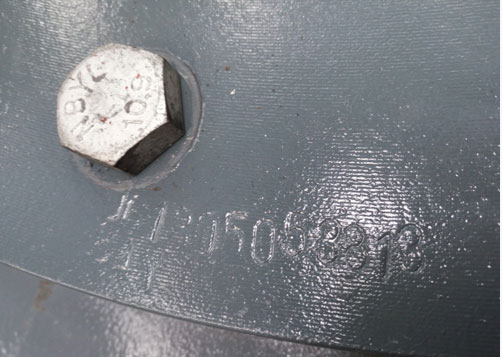
The permanent traceability NO. of pot bearing
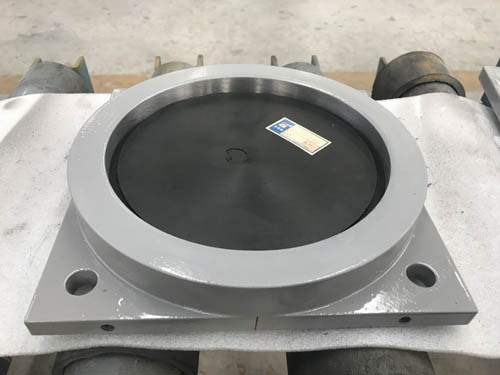
The elastomer disc (NR or CR)& pot
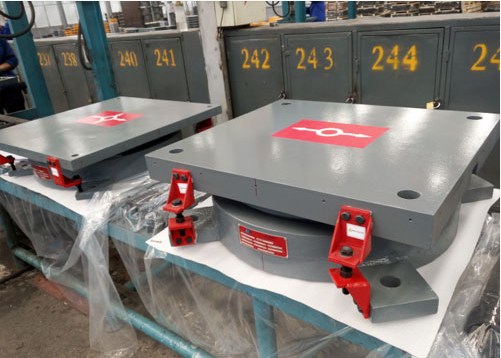
CE certificate pot bearing
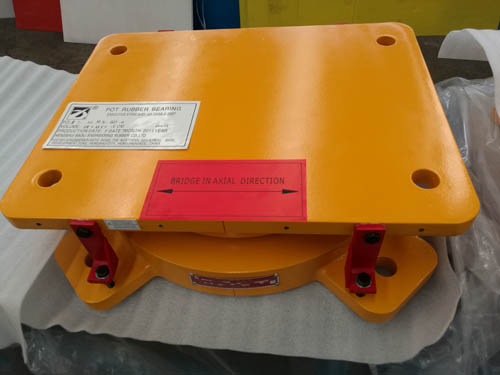
CE certificate pot bearing
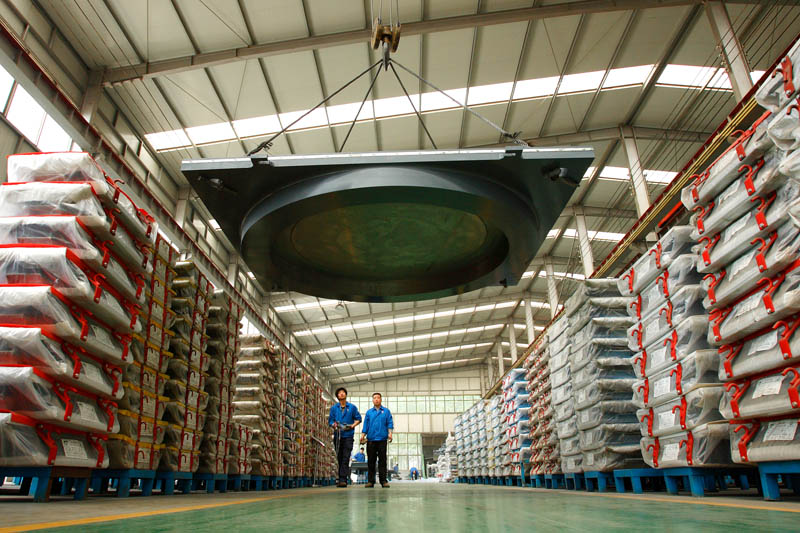
BAOLI PRODUCTS
QUOTATION:
Quotations are supplied on the basis of the types and numbers of the bearing required. We can also design the types of the bearing, if you proveded the follow information:
- Maximum, minimum and permanent vertical loads and corresponding horizontal loads(ULS).
- Displacement And Rotations in longitudinal and transverse directions.
- Other more information (like available space for pot bearing, concrete strength, etc).

